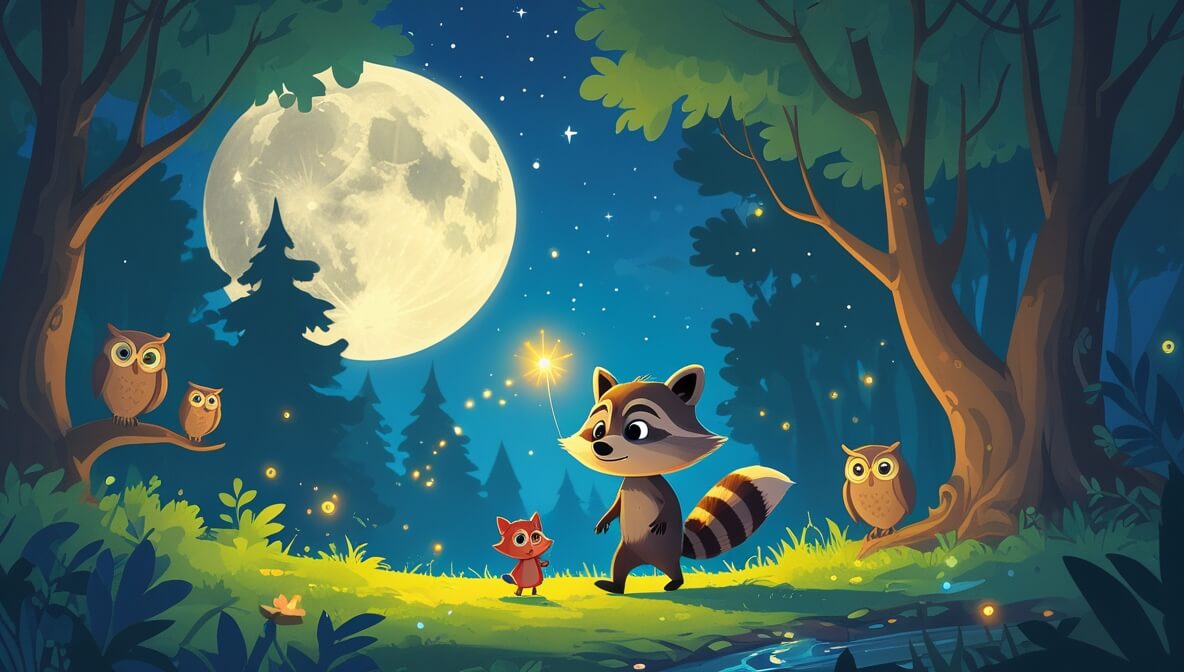Little Timmy the raccoon loves the moon but is a bit scared of the dark. One night, he decides to face his fears with the help of a magical friend.
Age Recommendation
0 – 4 years
Characters
Characters:
- Timmy (a curious raccoon with a love for the moon)
- Luna (a gentle, glowing firefly who becomes Timmy’s friend)
Story
One quiet night in the forest, little Timmy the raccoon looked up at the sky. The moon was so bright and round, it made Timmy feel calm and happy. But then he looked around at the shadows and felt a little scared.
The Moonlit Adventure Begins
Timmy wished he wasn’t afraid. Just then, a friendly firefly named Luna appeared. “Hello, Timmy!” she said, glowing softly. “Let’s go on an adventure!” Timmy hesitated but felt excited. With Luna’s light, the shadows weren’t so scary anymore.
Exploring the Forest
Together, Timmy and Luna explored the forest. They saw a family of owls, a sparkling stream, and even a sleepy fox. Timmy wasn’t scared because Luna was there, lighting the way.
Facing the Dark
As they wandered, Timmy realized something important. The dark wasn’t so bad. In fact, it was full of wonderful sounds and sights. He felt brave and happy.
The end.
Moral of the Story
Sometimes, things we fear are not as scary as they seem. With a little courage and good friends, we can explore and discover new wonders.
Questions to Think About
- Why was Timmy afraid of the dark?
- How did Luna help Timmy feel brave?
- What new things did Timmy see on his adventure?
- Can you think of a time when you were brave?
- Who helps you feel brave?
Do You Know
- Fireflies light up using a chemical reaction in their bodies. It’s like nature’s little flashlight!
- Raccoons are excellent climbers and can even swim.
Word Explorer
- Adventure: A fun and exciting journey.
- Glowing: Shining with a soft light.
- Brave: Feeling strong and not scared.
Emotions in the Story
- Scared: Timmy felt this when he looked at the shadows.
- Excited: Timmy felt this when Luna asked him to go on an adventure.
- Brave: Timmy felt this when he explored the forest.
Color Your Scene
Imagine Timmy and Luna walking through the forest. Draw them under the moonlight, with Luna glowing gently and guiding Timmy. Use bright colors for Luna’s light and soft blues and greens for the night forest.
Parents’ Corner
This story is a gentle way to talk about overcoming fears and embracing new experiences. You can connect it to nighttime routines by encouraging your child to think of their own bedtime as an adventure. Highlight the importance of having trusted friends or family members who make us feel safe, just like Luna did for Timmy. Encourage your child to talk about their own fears and how they might be less scary with a little help and courage.











